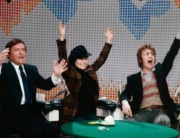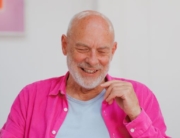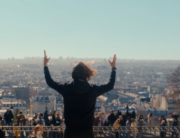Nick Cave must say the word transformation about a half a dozen times in the quash-documentary 20,000 Days on Earth. It’s what he feels art does in life, what he accomplishes in his work, and what his work does to him. Film being, on many occasions (and certainly this one), works of art, don’t expect a straight ahead doc from this man. And don’t expect the truth, but there’s plenty of honesty. We are talking about a man who considers his music a world distinctly separate from the one he lives in. One that is infinitely more comfortable for him. The fact that there is so much truth in Cave’s fantasy world is a testament to the man as an artist.
For fans of Nick Cave (as I am), this film is a treat. We see him typing away in a room in his house decorated with odd knickknacks as an old-school answering machine interrupts his reverie. I should say set decorated because this is a fanciful look at Cave’s day.
He is filmed in a therapy session, he pores through old photos with people he describes as archivists. He drives around the English city of Brighton with former collaborators. Interestingly, after five minutes of conversation in the car, there will be a two-shot and you see an empty seat where, for example, actor Ray Winstone was just sitting. This gives the impression that Cave was conversing with his mental image of his passengers. Taking stock, as it were. And this what makes 20,000 Days unique. It is clearly what Nick Cave thinks a film about Nick Cave should look like. He manages to reveal what he wants and still retain his mystique.
The most straightforward moments come when he is clearly the most comfortable: creating music. He gives tantalizing glimpses into his process. We watch him work up songs for his upcoming album Push Away the Sky with his erstwhile partner, the bearded, quixotic Warren Ellis. All the art and set decoration and the (occasionally) portentous voice-over are gone. And you feel you see Nick Cave as he is.
Of course, again, it could be misdirection. He can be as inscrutable as Bob Dylan. Ellis himself is a formidable presence. Looking, quite frankly, like a well-dressed, if not well-groomed, homeless man, he is a soft-spoken, genteel presence. On stage, however, he is a whirling dervish practically shredding his violin strings. He and Cave have an amusing conversation where Ellis mentions he has had more meals with Cave than he has had with his wife.
After watching Cave discuss his life, reminisce, and pontificate, the last 10 minutes are given over to what most of his fans adore him for: his ferocious live performances. Kylie Minogue describes him onstage as a tree. Arms outstretched and waving about menacingly like the branches of an oak in the billowing breeze, Cave towers over the crowd, shuffling, crooning, acting out (to his own admission) psychodramas with the audience in the front row. You sense the transformation he keeps referencing. He is truly in the world he describes creating. And, in that moment, he is visibly content.







Leave A Comment